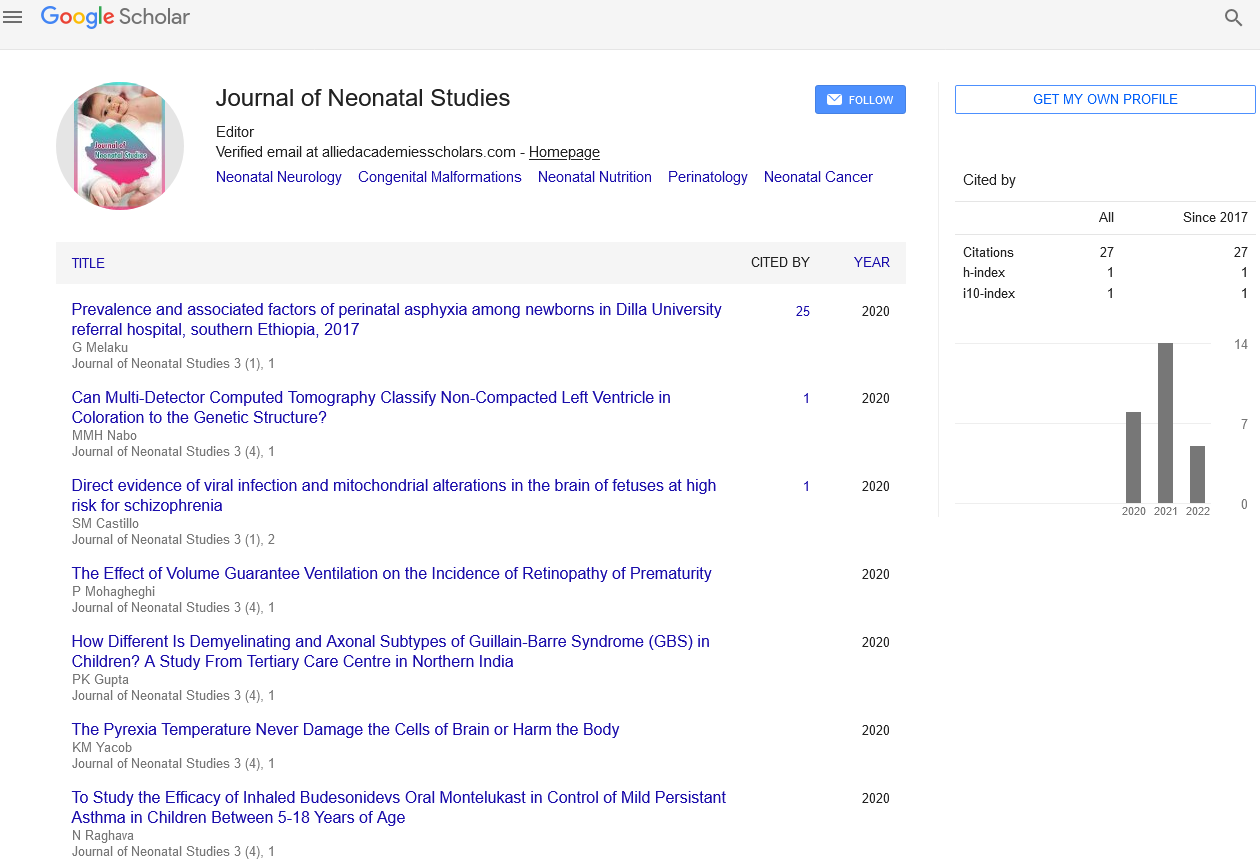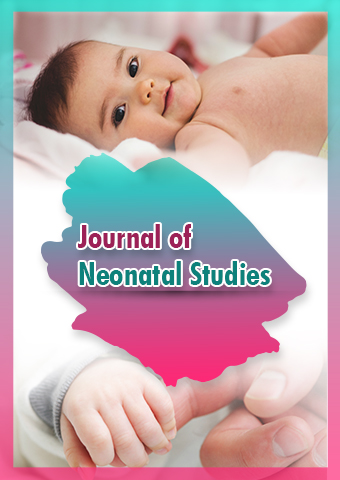Mini Review - Journal of Neonatal Studies (2023) Volume 6, Issue 4
Neonatal Surgery: Pioneering Interventions for the Tiniest Lives
Hellen Marker*
Department of Stem Cell and Research, Georgia
Department of Stem Cell and Research, Georgia
E-mail: markertisue@gmail.com
Received: 01-Aug-2023, Manuscript No. jns-23-109490; Editor assigned: 2-Aug-2023, PreQC No. jns-23- 109490(PQ); Reviewed: 15-Aug-2023, QC No. jns-23-109490; Revised: 22-Aug-2023, Manuscript No. jns-23- 109490(R); Published: 29-Aug-2023; DOI: 10.37532/jns.2023.6(4).112-115
Abstract
Neonatal surgery, a specialized field within pediatric surgery, focuses on diagnosing and treating surgical conditions in newborns and infants during the first 28 days of life. The management of surgical disorders in this vulnerable population poses unique challenges due to their anatomical and physiological immaturity. This article presents a comprehensive overview of neonatal surgery, encompassing its history, key surgical conditions, diagnostic approaches, surgical techniques, and outcomes. The review emphasizes the importance of early detection and intervention, as well as the interdisciplinary collaboration between neonatologists, pediatric surgeons, anesthesiologists, and other healthcare professionals in optimizing patient care and improving long-term prognosis. The advances in neonatal surgery techniques and technology have significantly improved survival rates, but further research and ongoing advancements are essential to address existing challenges and enhance neonatal surgical care. Neonatal surgery represents a specialized branch of pediatric surgery that addresses surgical interventions in newborn infants, typically within the first 28 days of life. The field has witnessed significant advancements in recent years, driven by improvements in medical technology, surgical techniques, and perioperative care. This abstract provides an overview of the key aspects of neonatal surgery, including common conditions requiring surgical intervention, challenges faced, and the overall impact on patient outcomes. Neonatal surgery encompasses a wide spectrum of congenital and acquired conditions, with congenital anomalies being the most prevalent. These anomalies often involve critical organs such as the heart, gastrointestinal tract, central nervous system, and urinary system. Timely diagnosis and intervention are crucial to mitigate potential complications and improve survival rates. Surgical procedures may range from relatively simple to complex, necessitating a highly skilled and multidisciplinary team approach.
Neonatal surgery • Surgical techniques • Newborn • Infants • Pediatrics
Introduction
The field of neonatal surgery is a medical specialty that focuses on surgical interventions for newborns, particularly those born prematurely or with congenital abnormalities. These delicate patients require specialized care, state-of-the-art equipment, and a multidisciplinary approach that brings together surgeons, neonatologists, anesthesiologists, and other medical professionals. Advancements in medical technology and our understanding of neonatal physiology have led to significant improvements in neonatal surgical outcomes over the years. Neonatal surgeons are now able to perform intricate procedures on the tiniest patients, ensuring their chances of survival and leading to better quality of life [1].
Neonatal surgery, a subspecialty of pediatric surgery, addresses a diverse range of surgical conditions affecting newborns and infants within the first 28 days of life. The neonatal period represents a critical developmental stage, where the immature anatomy and physiology of these tiny patients necessitate specialized and meticulous surgical care. In recent decades, remarkable progress in medical knowledge, technological advancements, and interdisciplinary collaborations have significantly improved the outcomes for neonates requiring surgical interventions. The birth of neonatal surgery can be traced back to the early 20th century, marked by pioneering procedures to correct congenital anomalies and life-threatening conditions. However, it was only in the mid-20th century that the field gained recognition and grew exponentially with the establishment of Neonatal Intensive Care Units (NICUs) and the refinement of surgical techniques [2].
This review aims to provide a comprehensive overview of neonatal surgery, encompassing its historical development, key surgical conditions commonly encountered, diagnostic modalities employed, and surgical approaches utilized. Additionally, we will explore the challenges unique to this population, including the delicate balance between surgical intervention and conservative management, the ethical dilemmas involved, and the critical role of parental involvement and support.
With improved neonatal care, advances in anesthesia, and a better understanding of neonatal physiology, the survival rates for neonatal surgical patients have steadily improved. Nevertheless, a multitude of challenges remain, such as preoperative diagnosis, optimizing timing of surgical intervention, minimizing complications, and addressing long-term outcomes. This article also sheds light on recent research and advancements that continue to shape the landscape of neonatal surgery, aiming to provide insights into future prospects and potential areas for further investigation [3].
Discussion
Importance of neonatal surgery
Neonatal surgery plays a critical role in managing congenital anomalies and life-threatening conditions that require immediate attention. Some of the common conditions that necessitate neonatal surgery include congenital heart defects, gastrointestinal malformations, neural tube defects, esophageal atresia, and diaphragmatic hernia, among others.
Babies born with these conditions often face lifethreatening challenges right from birth. Without prompt surgical intervention, their chances of survival and normal development diminish significantly. Therefore, neonatal surgery is crucial in giving these tiny fighters a fighting chance at life [4, 5].
Challenges in neonatal surgery
Performing surgery on neonates comes with a unique set of challenges due to their fragile and underdeveloped bodies. Some of the primary challenges include:
Size and fragility
Neonates are incredibly small, with underdeveloped organs and delicate tissues. Surgical instruments and techniques must be adapted to accommodate their tiny anatomy.
Immature organ systems
Neonates’ organ systems are not fully developed, and this poses risks during surgery and anesthesia. Surgeons must be extremely cautious to minimize the impact on the baby’s overall health [6].
Invasive procedures
Many neonatal surgeries are complex and invasive, leading to potential complications and post-operative challenges.
Limited communication
Neonates cannot communicate their symptoms or discomfort, making it challenging to identify complications promptly [7].
Parental stress
Neonatal surgeries are emotionally challenging for parents who must navigate the uncertainties and anxieties associated with their baby’s condition.
Advancements in neonatal surgery
Despite these challenges, remarkable advancements in neonatal surgery have significantly improved outcomes and the quality of life for these tiny patients.
Some notable advancements include:
Minimally invasive surgery
Surgeons now use minimally invasive techniques, such as laparoscopy and thoracoscopy, for certain neonatal surgeries. These approaches involve smaller incisions, reduced trauma, and quicker recovery times [8].
Fetal surgery
In some cases, surgery is performed on the fetus before birth to correct certain anomalies. Fetal surgery offers the advantage of intervening earlier, which can lead to better outcomes.
Improved anesthesia techniques
Anesthesia protocols have evolved to cater specifically to the unique needs of neonates, reducing the risks associated with anesthesia administration.
Enhanced imaging
Advanced imaging technologies, such as MRI and 3D ultrasound, allow for more accurate preoperative planning and better visualization of neonatal anatomical structures [9].
Multidisciplinary care
Neonatal surgery requires a collaborative approach involving surgeons, neonatologists, pediatricians, and other specialists to ensure comprehensive and holistic care for the baby.
Outcomes and ethical considerations
Thanks to these advancements, the survival rates and long-term outcomes for neonatal surgical patients have improved significantly. However, ethical considerations are essential when deciding on surgical interventions for critically ill neonates.
The principle of beneficence, which focuses on doing what is in the best interest of the patient, is particularly relevant in neonatal surgery. The medical team must weigh the potential benefits of surgery against the risks and potential complications. They must also consider the baby’s overall quality of life and the emotional and financial toll on the family [10].
Conclusion
Neonatal surgery represents a remarkable field where medical expertise, cutting-edge technology, and compassionate care intersect to save the lives of the tiniest and most vulnerable patients. Advancements in surgical techniques, anesthesia, and imaging have significantly improved outcomes, providing hope for parents and a chance at a healthy life for their babies.
However, neonatal surgery also raises ethical dilemmas that require careful consideration by medical professionals, parents, and society. Striking the right balance between intervention and non-intervention is crucial to ensure that the best interests of these fragile neonates are prioritized at all times.
As medical research continues to advance, we can expect even more groundbreaking developments in neonatal surgery, further improving the prognosis and quality of life for these little fighters who inspire us all with their strength and resilience. Neonatal surgery plays a vital role in addressing congenital anomalies and lifethreatening conditions in newborns. The field of neonatal surgery has witnessed significant advancements in medical technology, surgical techniques, and post-operative care, leading to improved outcomes and increased survival rates for newborns facing complex surgical challenges. Neonatal surgical interventions are highly specialized and require a multidisciplinary approach involving neonatologists, pediatric surgeons, anesthesiologists, nurses, and other medical professionals. Their collaborative efforts ensure the best possible care for the tiniest and most vulnerable patients.
In the future, it is essential to focus on further enhancing neonatal surgical techniques, optimizing perioperative care, and promoting interdisciplinary collaboration to continue improving outcomes and overall quality of life for neonates requiring surgical interventions. By doing so, we can ensure that these vulnerable infants have the best chance to lead healthy, productive lives. Neonatal surgery will undoubtedly remain an indispensable aspect of modern medicine, offering hope and a brighter future for the tiniest patients and their families.
Acknowledgement
None
Conflict of Interest
None
References
- Headey D. Developmental drivers of nutrional change: a cross-country analysis. World Dev.42, 76-88 (2013).
- Deaton A, Dreze J. Food and nutrition in India: facts and interpretations. Econ Polit Wkly. 42– 65 (2008).
- Headey DD, Chiu A, Kadiyala S. Agriculture's role in the Indian enigma: help or hindrance to the crisis of undernutrition? Food security.4, 87-102 (2012).
- Acharya UR, Faust O, Sree V et al. Linear and nonlinear analysis of normal and CAD-affected heart rate signals. Comput Methods Programs Bio. 113, 55–68 (2014).
- Kumar M, Pachori RB, Rajendra Acharya U et al. An efficient automated technique for CAD diagnosis using flexible analytic wavelet transform and entropy features extracted from HRV signals. Expert Syst Appl. 63, 165–172 (2016).
- Davari Dolatabadi A, Khadem SEZ, Asl BM et al. Automated diagnosis of coronary artery disease (CAD) patients using optimized SVM. Comput Methods Programs Bio. 138, 117–126 (2017).
- Patidar S, Pachori RB, Rajendra Acharya U et al. Automated diagnosis of coronary artery disease using tunable-Q wavelet transform applied on heart rate signals. Knowl Based Syst. 82, 1–10 (2015).
- Harrison Paul. How shall I say it…?Relating the nonrelational .Environ Plan A. 39, 590-608 (2007).
- Imrie Rob. Industrial change and local economic fragmentation: The case of Stoke-on-Trent. Geoforum. 22, 433-453 (1991).
- Jackson Peter. The multiple ontologies of freshness in the UK and Portuguese agri‐food sectors. Trans Inst Br Geogr. 44, 79-93 (2019).
Indexed at, Google Scholar, Crossref
Indexed at, Google Scholar, Crossref
Indexed at, Google Scholar, Crossref
Indexed at, Google Scholar, Crossref
Indexed at, Google Scholar, Crossref
Indexed at, Google Scholar, Crossref

